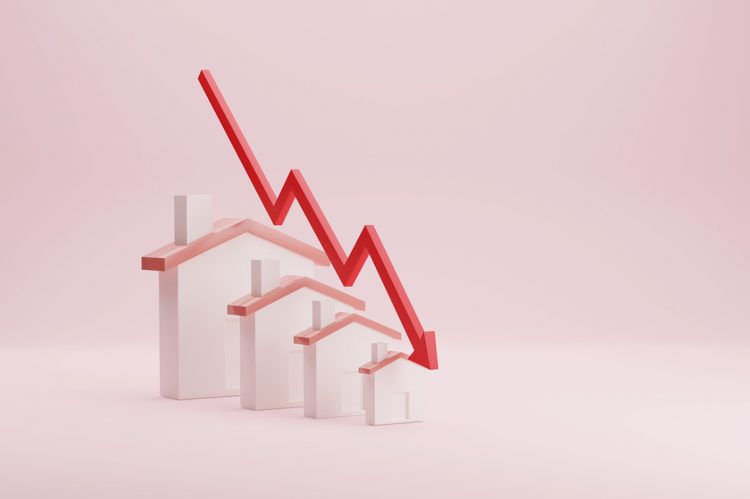Home price gains continued to cool for the seventh consecutive month, a trend that experts expect to continue through the spring, according to the latest S&P Case-Shiller Index.
The January index reported a 3.8% annual gain in home prices, down from 5.6% in the previous month. The 10-City Composite annual increase came in at 2.5%, down from 4.4% in the previous month. The 20-City Composite posted a 2.5% year-over-year gain, down from 4.6% in the previous month.
Miami, Tampa and Atlanta again reported the highest year-over-year gains among the 20 cities in January, increasing by 13.8%, 10.5% and 8.4%, respectively. All 20 cities reported lower prices in the year ending January 2023 versus the year ending December 2022.
The West Coast continued to display weakness in home prices, with San Diego and Portland joining San Francisco and Seattle in negative year-over-year territory. The Southeast, however, remains the country’s strongest region (+10.2%), and the West (-1.5%) remains the weakest.
The complete data for the 20 markets measured by S&P:
Atlanta, Georgia
January/December: -0.3%
YoY: 8.4%
Boston, Massachusetts
January/December: -0.3%
YoY: 4.2%
Charlotte, North Carolina
January/December: -0.3%
YoY: 8.1%
Chicago, Illinois
January/December: -0.5%
YoY: 4.8%
Cleveland, Ohio
January/December: -0.6%
YoY: 4.8%
Dallas, Texas
January/December: -0.9%
YoY: 5%
Denver, Colorado
January/December: -0.9%
YoY: 4%
Detroit, Michigan
January/December: -0.6%
YoY: 3.2%
Las Vegas, Nevada
January/December: -1.4%
YoY: 0.4%
Los Angeles, California
January/December: -0.2%
YoY: 0.9%
Miami, Florida
January/December: 0.1%
YoY: 13.8%
Minneapolis, Minnesota
January/December: -0.9%
YoY: 1.7%
New York, New York
January/December: -0.4%
YoY: 5.2%
Phoenix, Arizona
January/December: -1.2%
YoY: 0%
Portland, Oregon
January/December: -0.7%
YoY: -0.5%
San Diego, California
January/December: -0.4%
YoY: -1.4%
San Francisco, California
January/December: -1.3%
YoY: -7.6%
Seattle, Washington
January/December: -1.4%
YoY: -5.1%
Tampa, Florida
January/December: -0.7%
YoY: 10.5%
Washington, D.C.
January/December: -0.7%
YoY: 2.4%
The takeaways:
“2023 began as 2022 had ended, with U.S. home prices falling for the seventh consecutive month,” said Craig J. Lazzara, managing director at S&P DJI. “The National Composite declined by 0.5% in January, and now stands 5.1% below its peak in June 2022. On a 12-month basis, the National Composite is only 3.8% ahead of its level in January 2022, a result also reflected in our 10- and 20-City Composites (both +2.5% year-over-year).
“January’s market weakness was broadly based,” continued Lazzara. “Before seasonal adjustment, 19 cities registered a decline; the seasonally adjusted picture is a bit brighter, with only 15 cities declining. With or without seasonal adjustment, most cities’ January declines were less severe than their December counterparts.
“Financial news this month has been dominated by ructions in the commercial banking industry, as some institutions’ risk management functions proved unequal to the rising level of interest rates. Despite this, the Federal Reserve remains focused on its inflation-reduction targets, which suggest that rates may remain elevated in the near-term. Mortgage financing and the prospect of economic weakness are therefore likely to remain a headwind for housing prices for at least the next several months,” concluded Lazzara.
Bright MLS Chief Economist Dr. Lisa Sturtevant commented:
“The January S&P CoreLogic Case-Shiller Home Price Index confirms what we have been observing for months—rising mortgage rates and growing affordability challenges have led to slower home price growth.
“The slowdown in price appreciation does not come as a surprise. In January, average mortgage rates were about three percentage points higher than they had been a year earlier. The increase in mortgage rates have raised the monthly payment for a typical buyer purchasing a median-priced home by nearly $800 over the past 12 months. Alongside higher inflation overall—including higher prices for food, gas and all sorts of other household essentials—the higher monthly cost of homeownership has necessarily quelled the strong upward pressure on home prices. In high-cost markets like San Francisco and Seattle, affordability ceilings have been reached, and buyers have had more leverage to push prices down.
“Home prices are still rising in many markets, though, and the question might be, ‘why are prices still rising as much as they are in some places?’ The housing market remains relatively competitive in many markets, including markets throughout the Mid-Atlantic region where real estate agents report that two-thirds of sellers received multiple offers on homes sold in February, and a third of homes sold over asking price.
“There are two major reasons to explain why home prices are remaining firm in many local markets. First, despite the fact that inventory has increased from a year ago, supply is still very low by historical standards. Buyers in most markets still find themselves competing over relatively few homes for sale, a fact which continues to prop up home prices.
“Second, while rising home prices and higher mortgage rates have priced many buyers out of the market, other prospective buyers are still feeling upbeat about their financial situations and have been resolute in their decision to buy a home, particularly in more affordable markets. Repeat buyers—buyers who are selling one home to buy another—are able to bring record levels of housing equity to their home purchase, which has partially offset the impact of higher rates.
“Home price growth will likely continue to moderate this spring, and there may be modest year-over-year price declines in other cities. Barring a major recession, however, it is likely that the combination of low inventory and sufficient levels of demand will keep home prices from coming down significantly in most local markets. A significant recession with serious labor market impacts—which is not likely—is one way in which competition in the housing market could slow and prices could fall.”
Realtor.com® Economic Data Analyst Hannah Jones commented:
“Today’s S&P CoreLogic Case Shiller Index highlighted the struggles of buyers who were facing high prices, elevated mortgage rates and persistent inflation. The index tracks price figures for the months of November, December and January. The last month of 2022 and first month of 2023 saw mortgage rates dip below November’s highs, providing a small boost in activity. Existing-home sales continued to fall during this time, but by a smaller margin each month, as some buyers responded to lower mortgage rates by getting back into the market. However, less demand meant many would-be sellers chose not to enter the market, and many who chose to list had to settle for lower prices.
“Mortgage rates remained below their recent peak during February and March, clearing the way for a sizable rebound in existing-home sales in February. Prices have continued to soften as sellers in the market adjust to the price-level necessary to stoke buyer demand. As we move into the spring buying season, mortgage rates have ticked lower, a welcomed sign of progress towards affordability.
“At last week’s Fed meeting, Chair Powell noted that the recent instability in the banking sector is likely to lead to stricter lending requirements, which could trickle down to mortgage lending. The Fed raised the Federal Funds rate by 25 basis points, but acknowledged the potential end of the tightening cycle. Stricter credit requirements and a higher Federal Funds rate mean that it may be both harder and more expensive to borrow money, which both move the economy in the direction of slower growth and toward the 2% inflation target.
“This combination of events impacts the housing market by keeping mortgage rates higher than last year, and by making it harder for buyers to secure a loan. More expensive, less available borrowing, especially with an unclear economic outlook, is likely to continue to limit buyer demand. Though home sales are expected to rebound in line with seasonal trends, this spring’s sales pace is expected to remain lower than last year, as uncertainty and high costs limit activity. Many sellers will feel the pressure to list their home for a lower price to ensure sufficient buyer attention and a quick sale.”












